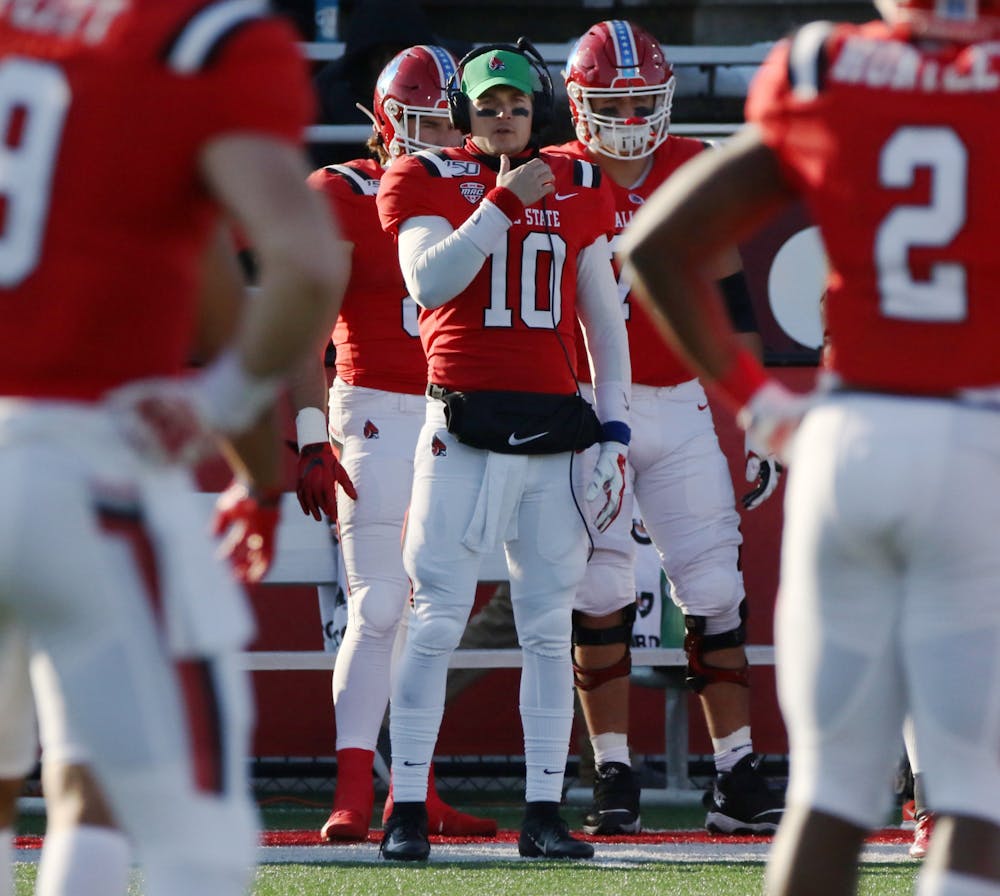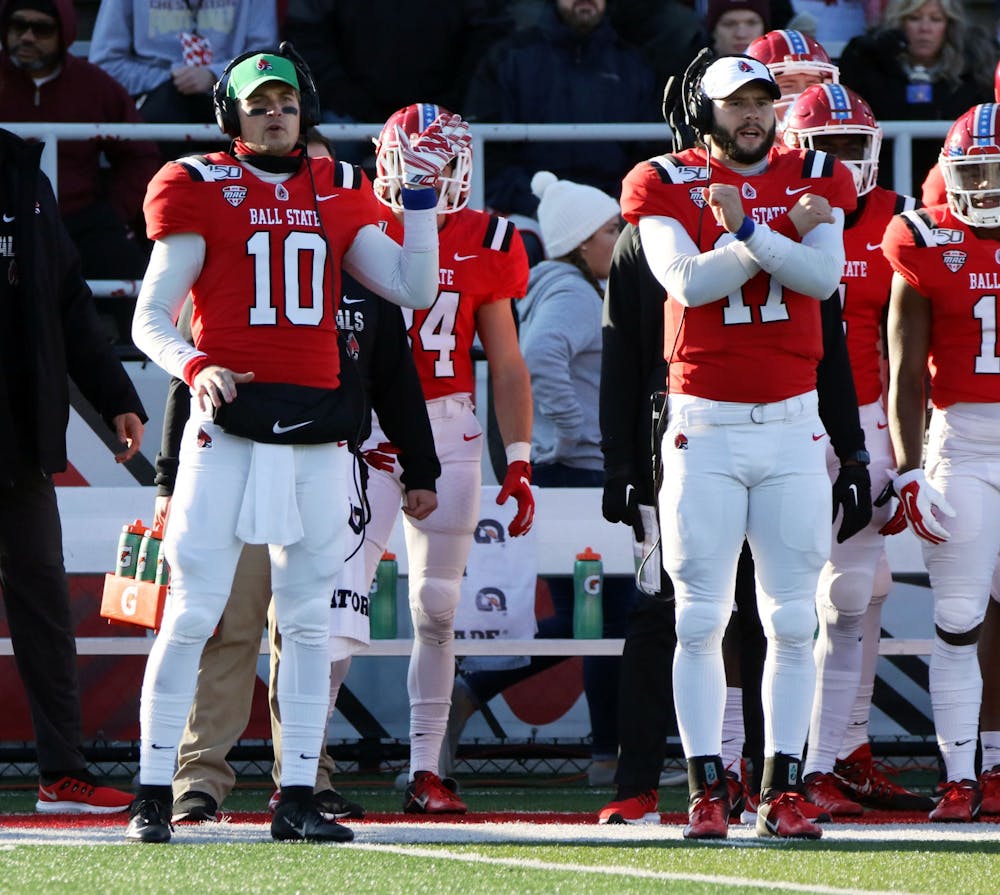What’s the meaning behind the different colored hats?
“I wish we could tell you.”
OK, what about dummy signals? You’ve got to have those, right?
“That’s confidential.”
Well, is there a specific order you give them in?
“I could tell you, but then I’d have to kill you.”
Each question was followed by laughter because they knew they couldn’t go into detail. They even apologized for not being able to answer in full.
But they couldn’t give anything away because their job is one of the most important jobs on game day.
“We are first priority on the sideline,” redshirt freshman quarterback John Paddock said. “We can knock everybody out of the way and get a good view of the game. ‘Got to signal. Watch out.’ Even the coaches too, so that’s kind of the fun part. You can throw a coach out of the way like, ‘I’m signaling.’”
Paddock, along with redshirt junior quarterback Hank Hughes and redshirt sophomore quarterback Elliot Charlebois, are three signal callers for Ball State Football. This means after the play is initially called, it’s relayed to the signal callers, who then communicate it to the players on the field through a series of various physical signals. This happens before every offensive play.
So, how many signals does the team have?
“Oh my gosh,” Charlebois said as his eyes got wide. “A bunch … I would guesstimate around 100. Each play is five to 10 signals.”
The Cardinals ran an average of 73 offensive plays per game through their first 10 contests. Multiply that by 10 signals for each play, and Paddock, Hughes and Charlebois are giving two signals for every calendar day in just one game.
“The first thing we do when we come in [for the week] is we go over new signals of the week,” Paddock said. “It’s definitely a major emphasis … You got to work at it, but it kind of flows smoothly.”

Ball State redshirt sophomore quarterback Elliot Charlebois gives signals to the offense during the Cardinals' game against Central Michigan Nov. 16, 2019, at Scheumann Stadium. Ball State lost, 45-44. Paige Grider, DN
The trio isn’t hard to find on game day. Not only do the signal callers get a front-row seat at the head of the sideline, but they sport different colored hats — most notably a bright blue and green. They said who wears which hat varies. Depending on what? They couldn’t say.
However, they could confirm who the best signal caller is.
“I am,” Hughes said right before Paddock helped change his mind. “Elliot. Elliot Charlebois … Me and Elliot are always competitive about everything.”
It wouldn’t be unrealistic to say “everything” either. At the start of this school year — Aug. 1 to be exact — Paddock, Hughes and Charlebois became roommates.
“From the time we end football, besides class, we’re hanging out every second of the day,” Paddock said. “We were actually just talking about that the other day. We’re literally together 24/7. It’s crazy.”
With how close the three have gotten this season — unexpectedly so, if you ask Charlebois — they said they have fun with their sideline job, especially when they know a funny signal is coming up.
“We have,” Paddock said before pausing to ponder what he could disclose. “We have some signals that maybe are a little promiscuous … Everyone will look at you. They’ll look at Elliot — he’s not the most coordinated guy. When he tries to do the dancing signals or something like that, it just looks funny.”
Even players on the field can’t help but laugh along.
“We always try to get [Charlebois] to give it again — act like we didn’t see it so he can do it again,” redshirt junior quarterback Drew Plitt said. “There’s some awkward ones that he’s not as good at doing, and it’s always funny trying to get him to do it again.”
What do all the signals mean?
“You’re pushing a little bit,” Hughes said with a laugh. “This is confidential. I don’t want to get in trouble with the coaches.”
They all said they’d rather be on the field playing, but at the end of the day, this is their job right now, and they’re approaching it as if it was their only.
“I take it pretty seriously,” Charlebois said. “I’ve been going live for a while now. You got to know your role on the team and take pride in whatever your role is — whatever gets the job done at the end of the day.”
That being said, each of them added they are more than prepared to jump into the game if needed.
“Coach harps on mental reps and how important those are as a quarterback,” Hughes said. “Obviously, only one can play the position, but if you’re staying locked in with the signals, with practice and doing your job as a quarterback, I feel like all three of us would be ready.”
When the time comes to take off their hat and put on their helmet, they’ll have to hope they didn’t get too used to giving the signals that they forget how to receive them.
“I’ve noticed a little bit,” Paddock said. “It switches, so the left’s the right. You know what I mean? … I’m like, ‘Wait, do it again,’ because sometimes I second-guess myself.”
Contact Zach Piatt with comments at zapiatt@bsu.edu or on Twitter @zachpiatt13.




